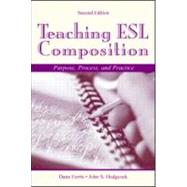
| Preface | ix | ||
| 1 Theoretical and Practical Issues in ESL Writing | 1 | (29) | |
|
|||
|
|||
|
|||
|
|||
|
|||
| 2 ESL Writing and L2 Literacy Development | 30 | (42) | |
|
|||
|
|||
|
|||
|
|||
|
|||
|
|||
|
|||
| 3 Syllabus Design and Lesson Planning in ESL Composition Instruction | 72 | (52) | |
|
|||
|
|||
|
|||
|
|||
|
|||
|
|||
|
|||
|
|||
|
|||
|
|||
|
|||
| 4 Text Selection, Materials Development, and Task Construction in ESL Composition | 124 | (60) | |
|
|||
|
|||
|
|||
|
|||
|
|||
|
|||
| 5 Teacher Response to Student Writing: Issues in Oral and Written Feedback | 184 | (39) | |
|
|||
|
|||
|
|||
|
|||
|
|||
|
|||
|
|||
|
|||
|
|||
|
|||
| 6 Building a Community of Writers: Principles of Peer Response | 223 | (37) | |
|
|||
|
|||
|
|||
|
|||
|
|||
|
|||
|
|||
| 7 Improving Accuracy in Student Writing: Error Treatment in the Composition Class | 260 | (39) | |
|
|||
|
|||
|
|||
|
|||
|
|||
|
|||
|
|||
|
|||
| 8 Classroom Approaches to ESL Writing Assessment | 299 | (45) | |
|
|||
|
|||
|
|||
|
|||
|
|||
|
|||
|
|||
| 9 Technology in the Writing Class: Uses and Abuses | 344 | (33) | |
|
|||
|
|||
|
|||
|
|||
|
|||
|
|||
| References | 377 | (38) | |
| Author Index | 415 | (10) | |
| Subject Index | 425 |
The New copy of this book will include any supplemental materials advertised. Please check the title of the book to determine if it should include any access cards, study guides, lab manuals, CDs, etc.
The Used, Rental and eBook copies of this book are not guaranteed to include any supplemental materials. Typically, only the book itself is included. This is true even if the title states it includes any access cards, study guides, lab manuals, CDs, etc.